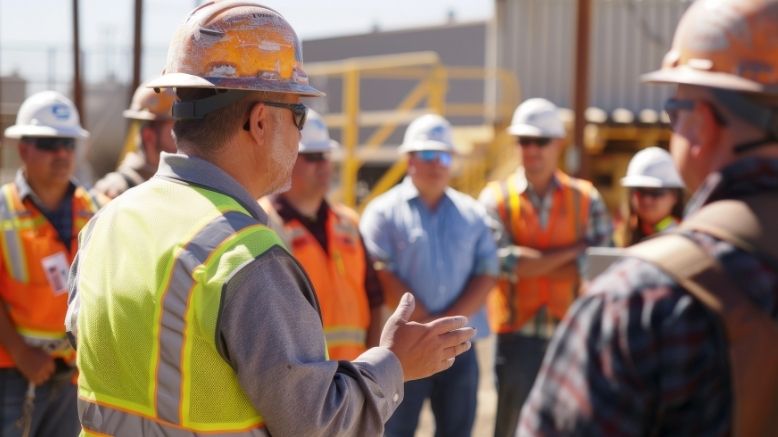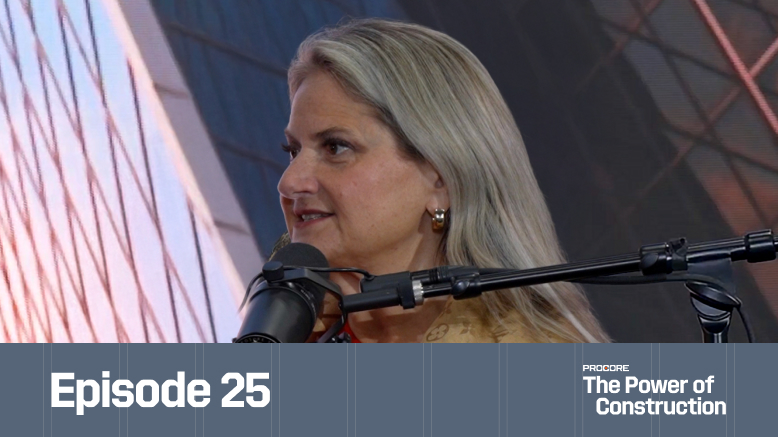— 14 min read
Construction Permitting: Essential Steps for Compliance and Approval


Last Updated Jun 6, 2025

Janine Trinidad
Staff Trainer and Program Manager
25 articles
Janine Trinidad is a Construction Educational professional for Procore Technologies. In previous roles, Janine managed all phases of construction on hotel, mixed-use, and institutional projects in the San Francisco Bay area. She was responsible for negotiating contract budgets and change orders, managing RFIs and submittals, and overseeing quality control, among other duties. She is also a certified transformational coach with a focus on women-centered and trauma-informed methods. She is passionate about transforming the construction industry to be a healthier, more successful and welcoming place to work and believes technology and education are allies in doing so.

Taylor Riso
Contributing Writer
91 articles
Taylor Riso is a marketing professional with more than 10 years of experience in the construction industry. Skilled in content development and marketing strategies, she leverages her diverse experience to help professionals in the built environment. She currently resides in Portland, Oregon.
Last Updated Jun 6, 2025

Before breaking ground, every construction project must pass through an important checkpoint: securing the necessary permits. Construction permitting isn’t just a formality — it’s the process that guarantees the project complies with local safety, environmental and building standards. These permits are issued by the Authority Having Jurisdiction (AHJ), providing legal approval for the work to begin.
This article explores the key components of the construction permitting process, outlining the role of the AHJ, the steps involved and how requirements can vary between municipalities.
Table of contents
Construction Permitting Across Various Jurisdictions
Construction permits are formal authorizations that allow a construction project to legally proceed. These permits are issued and regulated by the AHJ, the governing body responsible for verifying that the project complies with local standards. The permitting process typically involves submitting detailed plans — including construction drawings and project specifications — for review and approval by the AHJ. Without a valid permit, construction cannot legally begin.
Different Municipalities, Different Requirements
Permitting requirements can vary widely depending on the location of the project. Each municipality has its own set of rules and processes, which means that what is allowed in one city or area may not apply in another.
For example, in cities like San Francisco, regulations tend to be more demanding due to urban density, environmental concerns, design standards and stringent safety protocols. In smaller towns, the permitting process may be less complex, but the rules can still differ significantly.
To navigate these differences, it’s important for project teams to engage with the local AHJ early on. Visiting the building department or consulting the AHJ's website can provide valuable insight into the specific guidelines, required documentation and timelines for securing permits in that particular area. Understanding these local nuances helps to streamline the process and reduce the risk of delays due to unforeseen or unexpected regulatory requirements.
Who is responsible for obtaining a construction permit?
The property owner holds the ultimate responsibility for obtaining the necessary construction permits, as permits are directly linked to the property itself. While owners can delegate this task, they remain legally responsible for ensuring the project is properly permitted and follows local regulations.
Although the responsibility lies with the owner, it is common for the task of securing permits to be delegated to other members of the project team, generally the architect or general contractor. Architects usually take on this responsibility, leveraging their expertise in local building codes to navigate the permitting process efficiently. Their familiarity with code compliance and the creation of permit-ready drawings enables them to handle the submission and approval process smoothly.
In some cases, the general contractor may take on this responsibility, particularly if the architect's contract does not include permit management. When a general contractor is tasked with obtaining the building permit, the AHJ may require written authorization to apply for one on the owner’s behalf. Typically, contractors will pull their own work permits allowed by their particular licensing. Clear communication and defined roles in the contract help prevent misunderstandings and keep the permitting process on track.
Permit Set vs. Construction Set
The permit set of drawings is an important part of the permitting process. These documents are submitted to the AHJ to demonstrate that the project complies with local building codes and regulations. Developed during the architectural design process, the permit set is typically prepared once the design reaches a certain level of completion and is used to obtain legal approval to begin the project. The permit set focuses on compliance with zoning, safety and environmental codes in order to secure the necessary permits to break ground.
While the permit set is closely related to the construction set, they serve different purposes. The construction set, in contrast, is more detailed and focused on the actual execution of the project. It includes the specific instructions and specifications that the general contractor and subcontractors will follow on-site. The permit set should align with the construction set, but the construction set may continue to evolve as the project progresses, particularly as adjustments are made to address on-site conditions or contractual changes.
Managing Changes Between Permit and Construction Sets
A common challenge occurs when changes are made to the construction set after the permit set has already been approved. For instance, unexpected existing conditions, such as discovering an underground utility line that wasn't accounted for in the original design, may require changes to the construction set that differ from the approved permit set.
These adjustments can create discrepancies between the two sets of drawings, leading to potential confusion during construction. It is important for the general contractor to monitor and manage any differences between the approved permit set and the construction set to avoid issues with compliance or delays.
Managing this alignment between the two sets through good communication practices — like RFIs — helps make sure that the work performed in the field adheres to the legal approvals obtained from the AHJ.
Timing Conflicts Between Permit and Construction Sets
The timing of the permit set submission may overlap with other project preparations, such as contract negotiations with contractors and finalizing the construction set. This overlap creates a tight schedule, making the timely submission of the permit set a pressing concern. Delays in obtaining permits can have a cascading effect on the project timeline, particularly if the construction set changes before the permit has been approved. These changes can require further review by the AHJ, potentially slowing down the project’s progress.
The Permit Submittal Process
The permit process is made up of several steps that help a project comply with local safety, environmental and building codes before construction can begin.
Permit Application Submission
The first step is submitting the permit set of drawings to the AHJ. Along with the drawings, project details such as start and end dates and an estimated project value must be provided. Permit fees are typically calculated based on this value.
It is important to submit the permit set early in the project timeline because the review process can be lengthy, and construction cannot legally begin until the permit is granted. Any delays in submission can directly impact the project's start date and overall schedule.
Plan Check by the AHJ
After the permit application is submitted, the AHJ conducts a plan check. This review can involve several departments — building, fire, mechanical, electrical and plumbing (MEP), etc. — each examining the permit set for compliance with their specific codes.
The extent of the review varies depending on the complexity of the project and the number of regulations that apply. On larger projects, the review process can take longer as multiple departments may need to weigh in.
Permit Approval and Plan Check Comments
Once the plan check is complete, the permit may be granted, or the AHJ may issue plan check comments requiring revisions. Even after the permit is approved, there may be conditions that need to be addressed during construction.
For example, inspectors may request adjustments or clarifications based on their initial review. If significant changes are needed, revised drawings may need to be resubmitted for further review. Monitoring and addressing these comments promptly helps keep the project on schedule and ensures that the work complies with the permit requirements.
Permitting and the Inspection Process
After the project has received the necessary permits and construction begins, the focus shifts to a series of inspections designed to verify that the work on-site complies with the approved plans and local regulations.
Ongoing Inspections
Once the permit is granted and construction begins, the project moves into the inspection phase. This process checks that the work being carried out on-site adheres to the approved permit set and local building codes. Inspectors from varying disciplines validate that all aspects of the construction comply with the standards set forth in the plan check.
The general contractor is responsible for coordinating and managing these inspections. Inspectors visit the site at different stages of the project, such as after framing, before ceiling and drywall is installed and when mechanical, electrical installations or fire safety systems are in place. These inspections act as checkpoints to confirm that the construction work is progressing according to the approved plans and that no deviations occur without proper approval.
Job Cards and Inspector Approvals
To track compliance, the general contractor receives a job card once the permit is approved. This card must be kept on-site throughout the construction phase, as inspectors will use it to log their approvals at various milestones. Each time an inspection is successfully completed, the inspector signs off on the job card, providing a formal record that the work meets the required standards. Keeping the card updated enables the project team to monitor the progress of inspections and confirm that all required approvals are documented correctly.
Adjustments and Additional Inspections
Though the initial plan check covers the permit set, situations may arise during construction that require additional inspections or adjustments. For example, evolving safety protocols— especially from departments like fire safety — can introduce new requirements even after the project is underway.
These ordinances or adjustments, though rare, may require changes to the construction plans and subsequent inspections to help with continued compliance. Staying proactive in managing these changes helps the project avoid delays or complications during the final stages of construction and makes sure that the end product meets the highest standards of safety possible.
Permit Delays and How to Mitigate Them
Delays and risks in the permitting process can disrupt project timelines. With unpredictable approval times and the potential risks of starting work without full permits, careful planning and strategic approaches are needed to keep the project on track.
Unpredictability of Permit Approval Timing
One of the key challenges in the permitting process is the variability in the AHJ review timelines. The duration of a permit review can fluctuate greatly depending on factors such as project complexity and the volume of applications within a given municipality. In major or rapidly developing cities like San Francisco, New York City or Austin, for instance, high project volumes often result in extended review periods, delaying the start of construction.
Despite these uncertainties, building strong relationships with the AHJ can help expedite the review process. Informal consultations and ongoing communication with the reviewing departments can provide valuable insights into the review timeline and, in some cases, help move the project forward more quickly. Establishing connections with key personnel and proactively addressing potential concerns during the permit application phase can help mitigate some of the delays caused by the unpredictability of the review process.
Risks in Starting Construction Before Full Approval
To manage tight schedules, some teams may choose to begin certain portions of work before obtaining full permit approval. For example, demolition or site mobilization may commence under separate permits while the primary permit is still under review. However, this approach carries inherent risks. If issues arise during the review of the main permit, work that has already been completed may need to be revised or even halted, leading to additional costs and delays.
In some cases, project teams may choose to submit separate permit applications for different phases of the work to keep the project moving forward. This strategy allows teams to proceed with certain aspects of construction, such as exterior versus interior renovations, or Building A versus B, while waiting for final approval of the full construction permit. Although this phased approach can help maintain the schedule, it requires careful coordination and communication with the AHJ to ensure that all necessary approvals are obtained for each now separate project.
Best Practices for Construction Permitting
Permitting can be a complex, often unpredictable process that requires thoughtful planning and attention to detail. By staying ahead of potential setbacks and maintaining strong coordination across the entire project team, general contractors can tackle hurdles that arise and keep their projects on schedule.
Communicate clearly and document thoroughly.
Clear and consistent communication between the owner, architect and general contractor is fundamental to managing the permitting process effectively. Defining each party's responsibilities upfront in formal documentation prevents misunderstandings later. This includes contracts that clearly outline who is responsible for tasks such as permit submission, fees and responding to plan check comments. Strong documentation practices build accountability and transparency throughout the project.
Keep a detailed permit log.
Maintaining an organized permit log is key to staying on top of permit approvals and inspections. This log should include key details such as submission dates, approval timelines and permit expiration dates. Tracking these elements helps the project team know that all permits remain valid throughout the construction process and that inspections are scheduled and completed as required.
Additionally, critical documents like the job card — used by inspectors to log approvals throughout the project — should be kept on-site in a secure, fireproof safe. Protecting these records helps maintain compliance and prevents costly delays due to lost documentation.
Identify and Address Risks Early
Identifying potential permitting issues early in the design phase can prevent costly delays down the line. Complex or innovative design features — such as non-standard materials or cutting-edge building techniques — may raise concerns with the AHJ and require additional scrutiny. By flagging these issues early, project teams can make the necessary adjustments before formal submission, reducing the risk of complications during the plan check process.
Conduct pre-submittal reviews.
Conducting informal pre-submittal reviews with the AHJ or a permit consultant before formally submitting the permit set can help catch potential issues early. These informal reviews provide an opportunity to receive feedback from key decision-makers at the AHJ, allowing the project team to address concerns before they become obstacles during the formal review. By identifying and resolving issues ahead of time, project teams can avoid the risk of waiting several weeks for a formal review only to face unexpected comments and the need for resubmission. This can prevent compounding delays that could push the project timeline further back. Engaging in these reviews can streamline the approval process and reduce the likelihood of significant revisions after submission.
Consider expediting options when facing delays.
In some cases, delays in the permitting process may threaten to derail the project’s timeline. When time is a pressing concern, paying additional fees to expedite the permit review is one potential solution. Alternatively, hiring a permit expediter—someone who specializes in liaising with the AHJ—can help move things along more quickly. This option can reduce delays, especially in complex or heavily regulated jurisdictions, though it comes with added costs that should be budgeted for accordingly.
Stay updated on what’s happening in construction.
Subscribe to Blueprint, Procore’s free construction newsletter, to get content from industry experts delivered straight to your inbox.

The Digital Evolution of Permitting
With the adoption of technology into the industry, the permitting process is becoming more streamlined, helping to reduce delays and improve communication across all stakeholders.
Increasing Digital Submissions
In recent years, especially in the wake of COVID-19, many municipalities have begun shifting towards digital permitting processes. This transition allows for online submissions of permit applications and supporting documents, making the process more accessible and efficient for project teams. However, despite this progress, many AHJs still rely heavily on physical submissions, particularly for large-scale projects. While digital systems are becoming more common for tasks like scheduling inspections and requesting updates, full digital adoption varies across jurisdictions.
BIM and the Future of Permitting
The integration of Building Information Modeling (BIM) into the permitting process is an emerging trend that has the potential to streamline plan reviews. By using BIM, project teams can provide AHJs with a more detailed and holistic view of the project. This allows plan checkers to see how various systems interact within the building, reducing the likelihood of missed issues and improving overall efficiency.
Looking ahead, BIM and digital twin technologies could significantly enhance the permitting process by offering real-time data and simulations that support better decision-making. However, many AHJs have been slow to fully adopt these tools, and the shift toward fully digital permitting systems is still developing. While these technologies hold great potential for increasing efficiency, their broader implementation is still in progress.
Adapting to an Evolving Regulatory Environment
As the industry continues to grow, there will be heightened expectations for sustainability, safety and innovation in construction projects. This will likely lead to stricter permitting requirements and more involved oversight from regulatory bodies. Navigating these shifts requires a forward-thinking approach, where project teams are equipped not just to meet current standards but to anticipate future regulatory trends.
Was this article helpful?
Thank you for your submission.
86%
14%
You voted that this article was . Was this a mistake? If so, change your vote
Scroll less, learn more about construction.
Subscribe to The Blueprint, Procore’s construction newsletter, to get content from industry experts delivered straight to your inbox.
By clicking this button, you agree to our Privacy Notice and Terms of Service.
Thank you!
You’re signed up to receive The Blueprint newsletter from Procore. You can unsubscribe at any time.
Categories:
Written by

Janine Trinidad
Staff Trainer and Program Manager | Procore Technologies
25 articles
Janine Trinidad is a Construction Educational professional for Procore Technologies. In previous roles, Janine managed all phases of construction on hotel, mixed-use, and institutional projects in the San Francisco Bay area. She was responsible for negotiating contract budgets and change orders, managing RFIs and submittals, and overseeing quality control, among other duties. She is also a certified transformational coach with a focus on women-centered and trauma-informed methods. She is passionate about transforming the construction industry to be a healthier, more successful and welcoming place to work and believes technology and education are allies in doing so.
View profile
Taylor Riso
Contributing Writer
91 articles
Taylor Riso is a marketing professional with more than 10 years of experience in the construction industry. Skilled in content development and marketing strategies, she leverages her diverse experience to help professionals in the built environment. She currently resides in Portland, Oregon.
View profileExplore more helpful resources

Profit from Predictability: Construction Software as a Business Strategy
For general contractors, managing complex, multi-million-dollar projects, every project phase — from planning and budgeting to on-site execution — is an opportunity to lose time and money. Construction software is...

Defending Against Financial & Legal Risks on Megaprojects
The construction industry has seen marked growth in megaprojects. Some experts classify any project over $500 million as a megaproject, while others argue that the build needs to be $1...

Unlocking Project Intelligence: Moving from Raw Data to Actionable Insights
The construction industry faces a wide range of challenges, from ongoing labor shortages to frequent cost overruns. But some the biggest hurdles all stem from unpredictability. The general contractors (GCs)...

Who is accountable for innovation in construction?
Everyone says construction needs to innovate—but no one agrees on who’s actually responsible for making it happen. Is it the owner? The builders? The tech vendor? Or is innovation everyone’s...
Free Tools
Calculators
Use our calculators to estimate the cost of construction materials for your next project.
Templates
Find a template to help you with your construction project tasks.
Material Price Tracker
Get the latest U.S. retail prices and view historical trends for common building materials.
Glossary
Explore key terms and phrases used in the industry.
